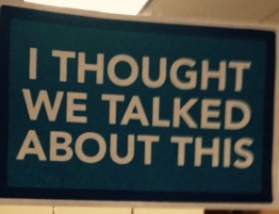
Why I am Writing this Blog
July 9, 2014
Workshops – Creating Collaborative Work Cultures
August 12, 2014CREATING A COLLABORATIVE WORKING ENVIRONMENT
Over the last few years there has been a movement to build an organizational culture that is grounded in collaboration. So what is Collaboration? And how do you build and maintain this type of culture?
First, let’s define some key words and concepts:
Collaboration -Working together to do a task and to achieve shared goals, by sharing knowledge, learning, and building consensus.
Consensus Decision Making – A group decision process that seeks the consent of all participants. 1st, it is agreement – 2nd, it is group solidarity of belief or sentiment, for both the decision and the process.
As you can tell by these definitions, the goal of a collaborative culture is to have people working and acting together with a common belief – as opposed to working in a competition for a selfish benefit.
My entire Blog is full of articles that describe behavior/activities that are focused on helping to build collaborative working cultures. Throughout my career I have believed and experienced that being in an environment that focuses on people working together, was far superior (effective and fun) to environments that used competition as the driving factor.
When I started my own restaurant/dessert business Treats, it was built on the premise of treating all of the employees as part of the Treats Family. Employees would come into the building as a customer and if we got busy they would leave their seats and without asking, do whatever they could to handle the crowds.
When I was hired as the Department Store Director of Training at the Bon Marche, my 1st task was to manage the Quality Circles’ effort with the Credit Department, helping facilitate the employees in defining the environmental needs that they, the employees, believed would improve moral and production.
While I have always believed in the cooperative concept, the world seemed to be obsessed with the concept of driving competition. It was not until about 2 weeks ago that I finally understood why this happened; the Baby Boomers have been in a competitive battle during their entire lifetimes – we were this large group of individuals that changed everything before us, and we had to compete against ourselves for everything. The way you could tell if you were winning was by comparing yourself or your organization to the competition. Well, it did drive the way the world grew, but as you look to the Millennial generation and the impact of the new online social systems – everything they do is about sharing. Their lives are not anything like the Boomers. “We Competed, They Share”
The building of a cooperative working culture really involves looking at everything an organization does with the definitions above in mind.
Collaboration-Working together to do a task and to achieve shared goals, by sharing knowledge, learning, and building consensus.
The rest of this post will be an effort to list all of the elements that I have written about, with a few key thoughts that are important with each element. This list will serve as the foundation for you as a team leader to audit your culture and to see where and how you can create and sustain a cooperative working culture.
[seperator style=”style1″]Seminar Outline[/seperator]
THE MANAGEMENT BEHAVIORAL SKILLS THAT BUILD A COOPERATIVE WORKING ENVIRONMENT
#1 IT STARTS WITH CLEAR VISION AND EXPECTATIONS
Vision as:
The act or power of imagination; Something seen as a dream, trance or ecstasy;
Mode of seeing or conceiving.
Expectations:
To anticipate or look forward to –the act of expecting an agreed upon behavior.
- How sure are you, that your employees understand what is expected of them in a variety of situations? Do you believe that everyone on your team understands what success looks like? And as a group has solidarity of belief for both the vision as well as the plan on how to get there?
[Score your confidence 1-10 with 10 being high]
Articles for reading:
The Power of Clear Vision—Thoughts about Communication—Job Descriptions – A Forgotten Asset.
#2 UNDERSTANDING HOW TO BUILD TRUST AND SHARED VALUES
Trust;
The One Thing That Changes Everything
How trust affects the trajectory and outcome of our lives- both personally and professionally – and what we can do to change it.
Values;
Most employee problems are related to a difference in values. In the business environment your values are reflected in three distinct kinds of decisions: How you spend money, how you use your time, and how you treat other people.
- What is the level of mutual trust with your team? Do all of your team members share the same values?
[Score your team’s mutual trust level and shared values 1-10 with 10 being high]
Articles for reading:
Cliff Notes for the Speed of Trust by Steven Covey—The 8 Interpersonal Behavioral Skills that Build Trust—Thoughts about Values—Cross training, A way to Common Values
#3 THE ART OF MAKING DECISIONS
Decision making can be regarded as the cognitive process resulting in the selection of a belief or a course of action from among several possibilities.
Every decision making process produces a final choice.
Participation allows individuals and groups to influence the decision in a representative manner.
- How well do your team members understand how decisions are made under your leadership? How much input do your team members have in the decision process?
[Score your team’s trust in your decision process 1-10 with 10 being high]
Articles for reading:
The Art of Making Decisions–Focus and Edit
#4 JOB DESCRIPTIONS- A FORGOTTEN ASSET
Joe descriptions are written statements that describe the duties, responsibilities, and most important contributions and outcomes, from an employee’s position. The description also states the required qualifications and reporting relationships of this particular job.
- Do you regularly [at least 1 time per year] discuss your team members’ Job Descriptions?
[Score your effective use of Job Descriptions in managing you employees- 1-10 with 10 being high]
Articles for reading:
Job Descriptions – A Forgotten Asset
#5 THE USE OF REVIEWS
Reviews are a basic element of all organizations, and one of the most disliked aspects of the job, from the perspective of both the employee and the manager.
Reviews normally happen yearly at a specific time of year and serve as an interview between the manager and employee to discuss how the employee has performed during the year. Most organizations have a specific evaluation system that has implications as to the employee’s salary and organizational value.
- How would you rate your ability to have the review process be viewed as a worthwhile experience for both you and your employees?
[Score your team’s trust in the annual review process 1-10 with 10 being high]
Articles for reading:
#6 DESIGNING AN EMPLOYEE REWARD SYSTEM
The primary goal of a reward/recognition system is to increase the frequency of an employee action or behavior. An award system is usually associated with an organization’s strategic initiatives.
Reward and recognition efforts can focus on 2 different concepts – individual competition, or a greater emphasis on group behaviors.
- How would you rate your employee reward/recognition efforts?
[Score your teams reward/recognition system 1-10 with 1 being very individual competition and 10 being totally group focused]
Articles for reading:
Designing an Employee Rewards System
#7 DEALING WITH POOR PERFORMANCE EMPLOYEES
In every organization there are people that are viewed as Poor Performers, not meeting the standards of the group. Most of the time these poor performers are also viewed as having Bad Attitudes. As other employees see these behaviors, they become very interested in how the manager handles this situation.
- How comfortable are you handling the poor performing employee?
[Score your level of confidence in handling poor performance employees 1-10 with 10 being high]
Articles for reading:
Dealing with Poor Performance Employees [coming soon!]
#8 DEALING WITH CONFLICT
Conflict Management is the process of limiting the negative aspects of a conflict while increasing the positive aspects of conflict. The aim of conflict management is to enhance learning and group outcomes including effectiveness or performance in organizational settings.
- How comfortable are you at managing conflict in a way that improves performance?
[Score your level of confidence in handling internal conflict 1-10 with 10 being high]
Articles for reading:
#9 MANAGING ORGANIZATIONAL CHANGE
Organizational change is actually a process in which an organization optimizes performance as it works toward its ideal state. Organizational changes occur as a reaction to an ever-changing environment, a response to a current crisis situation, or as triggered by a leader.
- How comfortable are you with organizational change? Do you have a clear understanding as to what you need to do to manage organizational change?
[Score your level of confidence in handling Organizational Change 1-10 with 10 being high]
Articles for reading
The Concept of Organizational Change – The 3 Types of Management—Know Yourself and Understand Others
#10 HOW TO BE CREATIVE
Creativity is the phenomenon whereby something new and valuable is created. The ideas and concepts so conceived can then manifest themselves in a number of ways, but most often they become something you can see, hear, smell, touch, or taste.
Organizational Creativity includes 3 fundamental concepts:
APTITUDE- The capacity to modify, change, or innovate
SYSTEM- Creativity is not just individual in nature; Social systems, Organizational Cultures, and any Enterprise – all require the capacity to change
EVOLUTION- Change is a necessity, but not sufficient condition in order to define Creativity
- How comfortable are you at finding ways to be creative? Do you have a system for fostering your team’s creativity?
[Score your level of confidence in inspiring you teams creativity 1-10 with 10 being high]
Articles for reading:
#11 BUILDING A SOCIAL ENVIRONMENT
“There is something deeply important about an experience of being in the presence of someone without being impinged upon by their demands, and without them needing to make a demand on you. And this creates a space where someone can feel sufficiently safe as though there is a shield, or someone guarding you against dangers such that you can forget your self and be open to trust of and connection to others”. – [The Paris Review with Adam Phillip]
It All Starts With A Conversation
CONVERSATION – is a form of interactive spontaneous communication between 2 or more people who are following the rules of etiquette. It’s a polite give and take of subject thought by talking with each other for company.
- How well do you engage individuals and small groups in Conversation that allows for equal exchange of information?
- How comfortable are you engaging, considering the time pressures of your workday?
[Score your level of comfort with just being socially engaged 1-10, with 10 being very good]
Articles for reading:
Creating a Collaborative Environment
#12 HOW TO USE FEEDBACK [INTERNAL AND EXTERNAL]
Feedback is information about how we are doing in trying to reach a goal. Feedback can be unstructured and random or it can be an effective system to measure the speed and impact on achieving well-defined initiatives. Given a manager’s ability to establish clear vision and expectations, feedback is the most powerful tool to judge any and all progress at accomplishing and meeting the vision and expectations.
- Does your management style have a feedback component? Is this feedback component a regular part of your behaviors?
[[Score your level of comfort with having a feedback system and you comfort in receiving the feedback 1-10, with 10 being very comfortable]
Articles for reading:
How to Use Feedback [Internal and External]
#13 PERSONAL AND PROFESSIONAL GROWTH THROUGH NETWORKING
There are a multitude of things that you can learn about yourself by being an active networker. In today’s social media world, we lose sight of the power of a conversation between two people exchanging ideas and knowledge about a common topic of interest. Networking, when done right, can have an explosive impact on your career and life. The lesson is understanding that networking keeps no score. Networking is about the relentless effort to connect people interested in learning to other people interested in learning.
- How well do you Network? Is Networking a part of your self improvement strategy?
[Score your level of Networking as a consistent personal growth strategy 1-10 with 10 being very high]
Articles for reading:
Personal Growth through Networking
#14 HOW TO MEASURE PERFORMANCE IN A COLLABORATIVE CULTURE
What you measure is what you get. The importance of having a well known and understood matrix of timely and frequent reports that all team members take ownership of, is critical to the success of any organization and team. In a perfect world, these elements would be a combination of business indicators [sales growth-expense margins –etc] as well as scores that define the important human engagement levels. [Do employees have passion and accountability to the culture and the business?]
- Do you have a consistent “Dash Board Report” that gives a tangible score to measure you team’s progress?
- Does this “Dash Board Report” have a high level of transparency and trust that the employees can have an impact on its results?
[Score your level of consistency at positively using this Dash Board report to manage your team 1-10 with 10 being very high]
Articles for reading:
How to Measure Performance in a Collaborative Work Environment
#15 BUILDING A COLLABORATIVE WORKING ENVIRONMENT: YOUR PERSONAL LEADERSHIP/MANAGEMENT SCORE
Add up your scores and look at the level of active behaviors you have adopted in creating a Collaborative Working Environment
90%=126 80%=112 75%=105 70%= 98 60%= 84 50%=70
Now look at your 5 -7 lowest scores and ask yourself: What activities would I like to learn that would have a significant positive impact on improving my team’s collaboration and overall productivity?
Next Steps:
Your scores will be aggregated into the Management teams’ overall scores and we will pick 5-7 core activities to be discussed at next week’s Management seminar. Please read the attached articles on the chosen topics, search the web for additional input on these topics and come to the seminar prepared to discuss the most important AH-HA that you received, while preparing for this seminar.
What Success Looks Like:
When you have completed this seminar, you will walk away with 3-5 activities that will build your team’s collaboration capacity.





